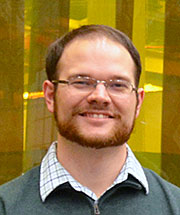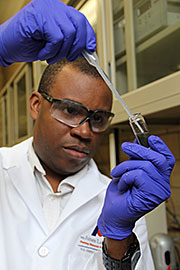- Number 447 |
- September 7, 2015
-
Scientists propose an explanation for puzzling electron heat loss in fusion plasmas
The results, published in June in Physical Review Letters, could lead to improved control of temperature in future fusion devices, including ITER, the international fusion facility under construction in France to demonstrate the feasibility of fusion power.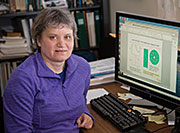 Creating controlled fusion energy entails many challenges, but one of the most basic is heating plasma – hot gas composed of electrons and charged atoms – to extremely high temperatures and then maintaining those temperatures. Now scientist Elena Belova of DOE's Princeton Plasma Physics Laboratory (PPPL) and a team of collaborators have proposed an explanation for why the hot plasma within fusion facilities called tokamaks sometimes fails to reach the required temperature, even as researchers pump beams of fast-moving neutral atoms into the plasma in an effort to make it hotter.
Creating controlled fusion energy entails many challenges, but one of the most basic is heating plasma – hot gas composed of electrons and charged atoms – to extremely high temperatures and then maintaining those temperatures. Now scientist Elena Belova of DOE's Princeton Plasma Physics Laboratory (PPPL) and a team of collaborators have proposed an explanation for why the hot plasma within fusion facilities called tokamaks sometimes fails to reach the required temperature, even as researchers pump beams of fast-moving neutral atoms into the plasma in an effort to make it hotter. -
Antimatter catches a wave at SLAC
The scientists had previously shown that boosting the energy of charged particles by having them “surf” a wave of ionized gas, or plasma, works well for electrons. While this method by itself could lead to smaller accelerators, electrons are only half the equation for future colliders. Now the researchers have hit another milestone by applying the technique to positrons at SLAC’s Facility for Advanced Accelerator Experimental Tests (FACET), a DOE Office of Science User Facility. A study led by researchers from DOE's SLAC National Accelerator Laboratory and the University of California, Los Angeles, has demonstrated a new, efficient way to accelerate positrons, the antimatter opposites of electrons. The method may help boost the energy and shrink the size of future linear particle colliders – powerful accelerators that could be used to unravel the properties of nature’s fundamental building blocks.
A study led by researchers from DOE's SLAC National Accelerator Laboratory and the University of California, Los Angeles, has demonstrated a new, efficient way to accelerate positrons, the antimatter opposites of electrons. The method may help boost the energy and shrink the size of future linear particle colliders – powerful accelerators that could be used to unravel the properties of nature’s fundamental building blocks. -
Scientists discover precise location of active sites on popular catalyst
If active sites work slowly or fail quickly, the result is higher costs and lower production rates. To make better active sites, scientists need to see them. For the first time, a team led by researchers at DOE’s Pacific Northwest National Laboratory saw the active sites on well-known vanadium-based catalysts that are important in commercial processes for manufacturing such products as polyesters, sulfuric acid, synthetic resins, epoxy coatings and others.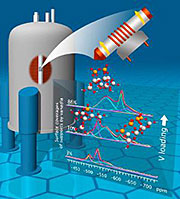 If you want to change a situation, it's often best to get to the heart of the matter. For chemists working to improve commercially important reactions, this means delving into the active sites on catalysts that speed the reactions behind billions of dollars’ worth of chemicals and other products. Active sites are where the reaction actually happens.
If you want to change a situation, it's often best to get to the heart of the matter. For chemists working to improve commercially important reactions, this means delving into the active sites on catalysts that speed the reactions behind billions of dollars’ worth of chemicals and other products. Active sites are where the reaction actually happens. -
Biological tools create nerve-like polymer network
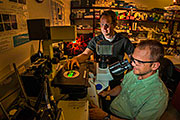 Using a succession of biological mechanisms, researchers at DOE's Sandia National Laboratories have created linkages of polymer nanotubes that resemble the structure of a nerve, with many out-thrust filaments poised to gather or send electrical impulses.
Using a succession of biological mechanisms, researchers at DOE's Sandia National Laboratories have created linkages of polymer nanotubes that resemble the structure of a nerve, with many out-thrust filaments poised to gather or send electrical impulses.“This is the first demonstration of naturally occurring proteins assembling chemically created polymers into complex structures that modern machinery can’t duplicate,” said Sandia National Laboratories researcher George Bachand.
Sandia co-researcher Wally Paxton said, “This is foundational science, but one possibility we see, way down the road, is to use soft artificial structures like these to painlessly interface with the body’s nerve structures.”
